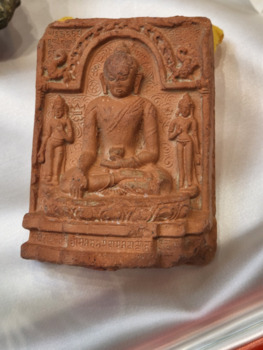Historical information
Tsatsas are small votive tablets shaped like deities, stupas, or sacred symbols. Buddhists may vow to create 100,000 tsatsas for purification and merit. These can be placed as an offering in holy sites, home altars, or gau boxes. Traditionally made of clay using moulds, tsatsas are dried, decorated, and blessed with mantras.
Significance
Portable nature of tsatsas allows them to accompany practitioners on journeys, providing spiritual protection and serving as a focus for prayer and meditation. Due to their inexpensive production and portability, tsatsas made a great contribution to the spread of Buddhism in Tibet.
Physical description
This tsatsa is of the Buddha in a sitting position, accompanied by two standing figures. The Buddha is richly adorned with delicate carvings around it.
Inscriptions & markings
The tsatsa features inscriptions in an ancient script.

